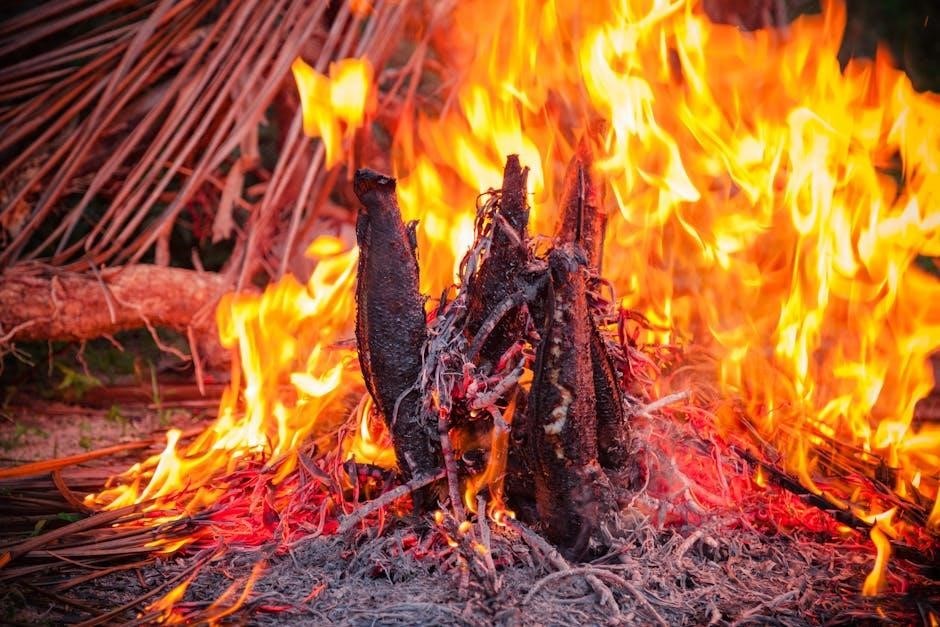A Witch’s Guide to Burning explores the intersection of magic, fire, and witchcraft, blending humor and poignancy. This graphic novel by Aminder Dhaliwal delves into themes of family, transformation, and the power of fire, offering a unique perspective on witchcraft and its cultural significance.
1.1. Overview of the Topic
A Witch’s Guide to Burning is a graphic novel by Aminder Dhaliwal that explores themes of magic, fire, and witchcraft. It delves into the lives of witches, their struggles, and their connections to fire as a transformative force. The story blends humor and poignancy, offering a unique perspective on witchcraft, family, and societal roles. The novel highlights the cultural and emotional significance of fire, weaving it into a narrative of transformation and renewal.
1.2. Importance of Fire in Witchcraft
Fire holds a primal significance in witchcraft, symbolizing transformation, purification, and spiritual growth. It is often used in rituals for cleansing, protection, and manifesting change. Fire represents the element of passion and energy, connecting witches to their inner power. In A Witch’s Guide to Burning, fire is central, reflecting themes of renewal and inner transformation, while emphasizing its cultural and emotional resonance in magical practices.
1.3. Historical Context of Burning in Magic
Burning has deep historical roots in persecution, as seen in witch hunts where fire symbolized fear. This violent history shaped cultural perceptions of witches. Yet, fire also holds a positive role in magic for purification and transformation, reflecting its dual significance.
The Role of Fire in Witchcraft
Fire in witchcraft symbolizes transformation and purification. It’s used in rituals for cleansing and protection. Its dual role as destructive and constructive is harnessed in spells.
2.1. Fire as a Symbol of Transformation
Fire is a powerful symbol of transformation in witchcraft, representing change and renewal. It destroys the old to make way for new growth. This dual nature mirrors human experiences of personal evolution. In rituals, fire is used to release negativity and embrace positive change. Its transformative power is central to many spells and ceremonies, making it a cornerstone of magical practices.
2.2. Fire Rituals and Their Significance
Fire rituals hold profound significance in witchcraft, serving as a medium for purification, protection, and divination. These rituals often involve burning herbs, candles, or written intentions to manifest change. Fire’s transformative power cleanses negative energy and amplifies spells. Community fire ceremonies foster unity and shared intention, while solitary practices deepen personal connection. The act of burning symbolizes release and renewal, making fire rituals a cornerstone of magical practice and spiritual growth.
2.3. Fire as a Tool for Purification
Fire is a potent tool for purification in witchcraft, used to cleanse spaces, objects, and energies. Burning herbs like sage or sweetgrass releases their purifying properties, while flames symbolize transformation and renewal. This practice, rooted in ancient traditions, helps remove negative influences and restore balance. The act of burning represents the destruction of impurities, allowing for a fresh start. It is a powerful method to create sacred environments and prepare for magical work.
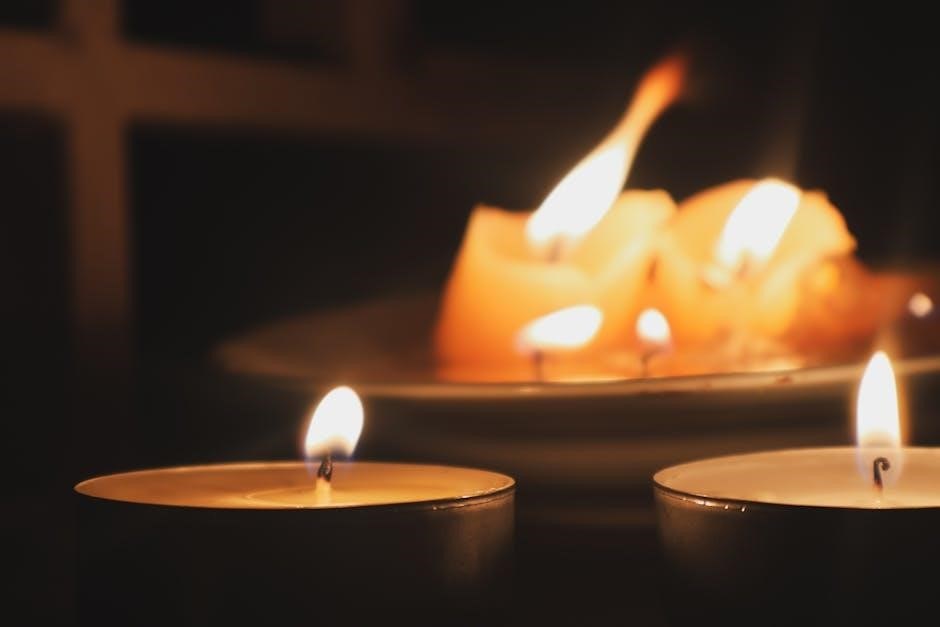
Historical Persecution of Witches
Historical persecution of witches often stemmed from fear and misunderstanding. Witch hunts, led by religious and societal fears, used fire as a brutal weapon, leaving lasting scars.
3.1. The Witch Hunts and Their Impact
The witch hunts were a dark period marked by fear, misinformation, and brutal executions. Many accused witches were targeted due to societal suspicion and religious zealotry.
The impact was devastating, leading to countless deaths and a lasting scar on communities. Fire became a symbol of both execution and fear, silencing magical practices and fostering misunderstanding for centuries.
3.2. Fire as a Weapon of Persecution
Fire was gruesomely used to execute accused witches during the witch hunts, symbolizing purification and divine judgment. This brutal method instilled terror, silencing magical practices and fostering a legacy of fear. The imagery of burning witches became a chilling reminder of societal intolerance and the dangers of unchecked power, leaving a deep scar on history and witchcraft’s perception.
3.3. The Legacy of Fear and Misunderstanding
The persecution of witches left a lasting legacy of fear and misunderstanding, rooted in centuries of misinformation. Fire, once a sacred tool, became a symbol of terror, associating witchcraft with danger. This historical trauma shaped societal attitudes, fostering mistrust and marginalization of witches. The lingering stigma influences modern perceptions, highlighting the need for education and understanding to reclaim the true essence of witchcraft and its connection to nature and magic.
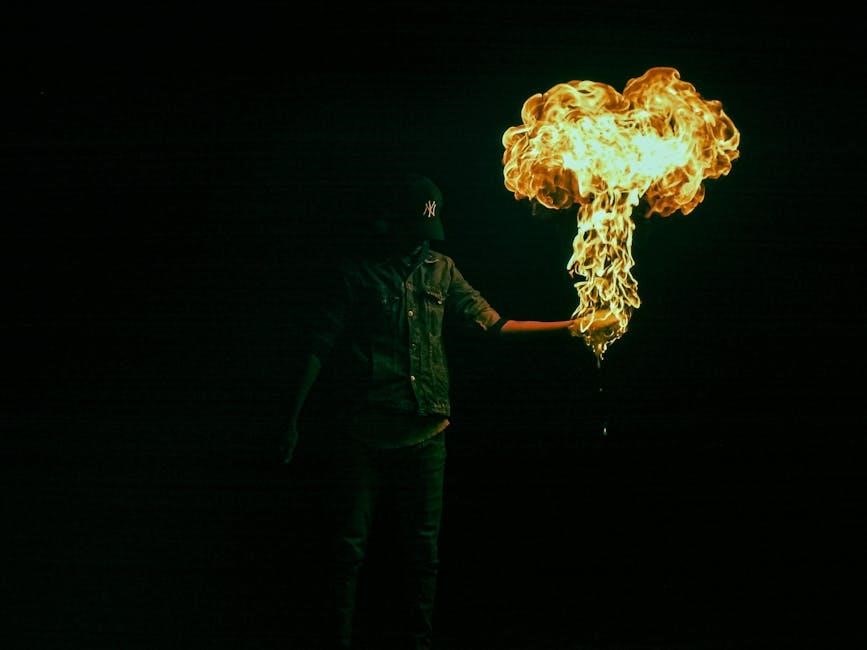
Modern Practices of Burning in Witchcraft
Modern witchcraft uses fire for spells, purification, and rituals, emphasizing safe practices. Burning herbs and candles aids in transformation, renewal, and emotional release, connecting witches to ancient traditions.
4.1. Safe Practices for Burning Herbs
Burning herbs in modern witchcraft requires careful preparation. Choose dry, organic materials to ensure clean combustion. Use fireproof containers and keep water nearby. Proper ventilation is essential to avoid inhaling harmful fumes. Never leave burning herbs unattended. Small, controlled flames are safer and more effective for rituals. These practices not only enhance safety but also respect the magical intent behind the burning, aligning with ethical and responsible witchcraft traditions.
4.2. Using Fire in Spells and Rituals
Fire is a powerful element in witchcraft, often used for purification, protection, and transformation. In spells, burning herbs or papers symbolizes releasing intentions to the universe. Rituals may involve candles, bonfires, or smudging to cleanse spaces. Fire’s energy amplifies magic, making it a popular tool for manifesting change. Always use caution, focusing intent and ensuring safety to harness its full potential effectively in magical practices.
4.3. The Role of Fire in Divination
Fire plays a significant role in divination, offering insights through its flames and embers. Practices like pyromancy involve interpreting fire’s movements to uncover hidden truths. Gazing into flames or burning herbs can induce meditative states, connecting practitioners to spiritual realms. Fire’s transformative power aids in revealing future possibilities and understanding present circumstances, making it a potent tool for witches seeking clarity and guidance in their magical journeys.

The Cultural Significance of Fire
Fire holds deep cultural significance, symbolizing transformation, purification, and spiritual connection across ancient and modern practices. Its universal appeal makes it a powerful element in witchcraft and beyond.
5.1. Fire in Ancient Cultures and Religions
Fire has been a sacred element in ancient cultures, symbolizing purification, divine connection, and transformation. In Vedic rituals, fire represented the divine breath, while Zoroastrians revered it as a symbol of truth. Similarly, ancient Greek and Roman religions used fire in sacrifices and rituals to honor deities. This reverence for fire transcended time, influencing its role in modern witchcraft as a tool for spiritual practices and magical rituals.
5.2. Fire as a Symbol of Life and Energy
Fire embodies life and energy, serving as a powerful symbol in witchcraft and beyond. Its flickering flames represent vitality, renewal, and the cyclical nature of existence. Witches often harness fire to channel energy, spark creativity, and fuel transformation. In A Witch’s Guide to Burning, fire is depicted as a source of both destruction and rebirth, mirroring life’s dualities and the enduring power of magic to shape and revitalize.
5.3. Fire in Modern Pagan and Wiccan Practices
In modern Pagan and Wiccan traditions, fire remains a central element, often used in rituals for purification, protection, and transformation. It symbolizes passion, creativity, and spiritual growth. Witches may incorporate candles, bonfires, or burning herbs to amplify spells and connect with divine energy. A Witch’s Guide to Burning reflects this, showcasing fire as a versatile tool that bridges the physical and mystical realms, reinforcing its enduring significance in contemporary witchcraft practices.

The Emotional and Spiritual Aspects of Burning
Burning evokes emotional release and spiritual connection, serving as a powerful catalyst for transformation. It helps witches process grief, anger, and fear, fostering inner renewal and healing.
6.1. Fire as a Catalyst for Emotional Release
Fire serves as a potent catalyst for emotional release, allowing witches to channel and process complex feelings like grief, anger, and fear. The act of burning symbolizes letting go, transforming negative emotions into a purifying force. This practice fosters renewal and healing, enabling individuals to confront and release burdens, creating space for emotional clarity and spiritual growth.
6.2. The Spiritual Connection to Flame
The spiritual connection to flame is deeply rooted in its symbolic and transformative power. Fire represents purification, renewal, and divine energy, often used in rituals to connect with higher forces. Witches view flames as a bridge between the physical and spiritual realms, fostering introspection and alignment with cosmic energies. This sacred bond is central to many practices, emphasizing fire’s role in spiritual growth and enlightenment.
6.3. Fire as a Tool for Inner Transformation
Fire serves as a powerful catalyst for inner transformation, enabling witches to confront emotions and release negativity. Through rituals, flames symbolize the destruction of old patterns, fostering renewal and personal growth. This process mirrors the graphic novel’s themes, where fire becomes a metaphor for self-discovery and healing. By embracing fire’s transformative energy, witches can align with their true selves, finding balance and empowerment in their spiritual journey.

Practical Guide to Burning
A Witch’s Guide to Burning offers practical steps for safe burning rituals, emphasizing material selection, preparation, and execution. It highlights fire’s role in purification and spells, ensuring effective, ethical practices.
7.1. Choosing the Right Materials for Burning
Selecting appropriate materials for burning is crucial in witchcraft. Herbs like sage, chamomile, and lavender are popular for their calming and purifying properties. Woods such as sandalwood and cedar are often used for protection and cleansing. Resins like frankincense and myrrh add depth to rituals. Always ensure materials are ethically sourced and safe for combustion. Avoid toxic substances to maintain harmony with nature and achieve desired magical outcomes.
7.2. Preparing for a Burning Ritual
Preparing for a burning ritual involves creating a sacred space, purifying the area with sage or salt, and setting clear intentions. Gather materials like herbs, woods, and resins, ensuring they align with your magical goals. Use a fire-safe container and have water nearby for safety. Focus on the ritual’s purpose, whether for purification, transformation, or protection. Center your energy and visualize the outcome to enhance the ritual’s effectiveness and connection to the flame’s power.
7.3. Executing the Ritual Safely and Effectively
Executing a burning ritual requires attention to detail and safety. Light the fire with intention, focusing on the purpose of the ritual. Use tongs or a wand to place items in the flames, ensuring they burn completely. Keep water or sand nearby to extinguish the fire if needed. As the fire burns, visualize the release of negative energies and the manifestation of desires. End by thanking the fire and safely disposing of ashes, completing the ritual with gratitude and mindfulness.
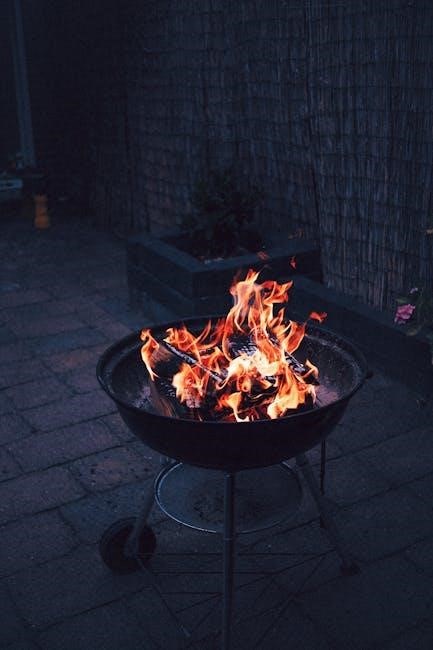
The Environmental Impact of Burning
Burning in rituals can harm the environment. To minimize damage, use sustainable materials and small, controlled fires. Responsible practices ensure respect for nature and its preservation.
8.1. Responsible Use of Fire in Rituals
Using fire responsibly in rituals is crucial for minimizing environmental harm. Opt for sustainable materials like ethically sourced herbs and wood. Keep fires small and controlled, ensuring they are extinguished properly after use. This not only respects nature but also aligns with the ethical principles of modern witchcraft, promoting harmony between magic and the environment.
8.2. Minimizing Environmental Damage
Minimizing environmental damage involves using eco-friendly materials and practicing fire safety. Choose locally sourced, sustainable items for burning to reduce carbon footprints. Avoid chemicals and synthetic substances, as they harm ecosystems; After rituals, dispose of ashes responsibly, ensuring they don’t pollute water or soil. This mindful approach respects nature and aligns with witchcraft’s core values of harmony with the environment.
8.3; Ethical Considerations for Modern Witches
Ethical considerations for modern witches involve respecting nature and minimizing harm. Burning rituals should avoid depleting natural resources and harming wildlife. Witches must ensure their practices align with environmental sustainability and cultural respect. This includes using responsibly sourced materials and avoiding practices that perpetuate ecological damage, fostering a harmonious relationship with the earth and its elements. Ethical awareness ensures that magic remains a force for positive transformation and renewal.
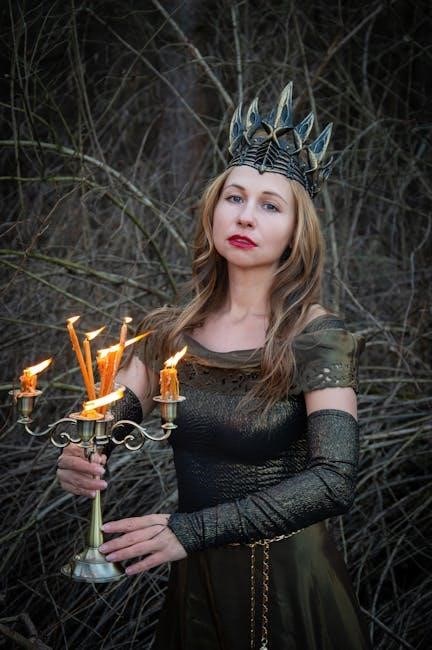
The Role of Fire in A Witch’s Guide to Burning
Fire is central to the story, symbolizing transformation, renewal, and magic. It highlights the dual nature of flames as destructive and life-giving, reflecting the witches’ journey.
9.1. The Central Theme of Fire in the Graphic Novel
Fire is a central theme in A Witch’s Guide to Burning, symbolizing transformation, renewal, and magic. It represents the dual nature of flames, both destructive and life-giving, reflecting the witches’ journey of self-discovery and growth. Through its use, the novel explores themes of power, resilience, and the cyclical nature of life, making fire a metaphor for the witches’ experiences and societal roles.
9.2. The Symbolism of Burning in the Story
Burning in A Witch’s Guide to Burning symbolizes purification, transformation, and renewal. It serves as a metaphor for confronting inner demons and societal expectations, reflecting the witches’ journey of self-discovery. The act of burning represents the destruction of negativity to make way for growth, while also highlighting the emotional and spiritual release that comes with it, making it a powerful narrative device in the story.
9.3. The Message of Transformation and Renewal
A Witch’s Guide to Burning conveys a powerful message of transformation and renewal through its portrayal of witches navigating magic and fire; The story highlights how challenges and trials lead to personal growth, emphasizing the importance of embracing change. By depicting witches as caretakers and healers, the narrative underscores the transformative power of magic and the cyclical nature of destruction and renewal, offering a hopeful vision of healing and regeneration.

The Community and Cultural Exchange
The community plays a vital role in sharing magical knowledge and cultural practices, fostering unity and strengthening witchcraft traditions through collective rituals and open dialogue.
10.1. The Role of Fire in Community Rituals
Fire serves as a unifying element in community rituals, symbolizing collective energy and transformation. It fosters a sense of unity, enabling witches to connect deeply with one another and their shared practices. Through fiery ceremonies, communities honor ancient traditions, strengthen bonds, and celebrate the power of magic, creating a space for healing and spiritual growth.
10.2. Sharing Knowledge Among Witches
Sharing knowledge among witches fosters a sense of community and preservation of magical traditions. Whether through exchanging tips on spellcasting or discussing the significance of fire rituals, this exchange strengthens bonds and ensures the continuation of witchcraft. It also promotes respect and understanding, allowing witches to learn from one another’s experiences and practices, thereby enriching their individual and collective journeys in the craft.
10.3. The Importance of Cultural Exchange in Witchcraft
Cultural exchange in witchcraft broadens perspectives and enriches magical practices. By sharing traditions, witches from diverse backgrounds foster mutual understanding and respect. This exchange allows for the blending of rituals, spells, and beliefs, creating a more inclusive and vibrant community. It also highlights the universal themes of transformation and renewal, as seen in A Witch’s Guide to Burning, where cultural diversity strengthens the collective power of witchcraft, promoting unity and evolution in the craft.

The Future of Burning in Witchcraft
The future of burning in witchcraft lies in evolving practices, blending tradition with modern innovation. Fire’s role will remain symbolic, adapting to cultural and environmental needs while preserving its transformative power, as explored in A Witch’s Guide to Burning.
11.1. Evolving Practices and Traditions
Modern witchcraft is embracing innovation while honoring ancient traditions. Fire rituals are adapting to environmental concerns, emphasizing safety and sustainability. Witches are exploring new ways to integrate fire symbolism, blending traditional practices with contemporary values. This evolution ensures that fire remains a powerful tool for transformation and spiritual growth, aligning with the themes explored in A Witch’s Guide to Burning.
11.2. The Role of Fire in Modern Witchcraft
Fire remains a central element in modern witchcraft, symbolizing transformation, purification, and spiritual connection. Witches use fire in spells, rituals, and divination, adapting ancient practices to contemporary lifestyles. Its primal energy is harnessed for cleansing spaces, releasing negativity, and amplifying intentions. As explored in A Witch’s Guide to Burning, fire’s versatility and symbolic power ensure its enduring relevance in modern magical practices, bridging tradition and innovation.
11.3. The Continued Relevance of Burning Rituals
Burning rituals remain vital in modern witchcraft, offering a powerful means of transformation and emotional release. Fire’s primal energy connects practitioners to ancient traditions while allowing for personal and contemporary interpretations. Its ability to symbolize renewal and purification ensures its enduring appeal. As highlighted in A Witch’s Guide to Burning, these rituals provide a timeless bridge between past and present, fostering growth and introspection in a rapidly changing world.
A Witch’s Guide to Burning masterfully blends humor, magic, and fire, offering timeless insights into transformation and renewal. Its enduring appeal lies in its universal themes of growth and resilience, making it a poignant and inspiring read for witches and non-witches alike.
12.1. Summarizing the Key Points
A Witch’s Guide to Burning masterfully explores the themes of fire, magic, and transformation through a blend of humor and poignant storytelling. The graphic novel delves into the cultural and spiritual significance of fire in witchcraft, highlighting its role in purification, rituals, and emotional release. By weaving together historical context, modern practices, and personal journeys, the book offers a comprehensive and inspiring perspective on witchcraft and its enduring power.
12.2. The Enduring Power of Fire in Witchcraft
Fire remains a potent symbol in witchcraft, embodying transformation, purification, and renewal. Its enduring power lies in its ability to transcend time, connecting ancient rituals to modern practices. A Witch’s Guide to Burning highlights how fire continues to inspire and empower witches, serving as a catalyst for spiritual growth and emotional release. Its significance endures, bridging cultural and historical gaps, ensuring its relevance in contemporary witchcraft and beyond.
12.3. Final Thoughts on A Witch’s Guide to Burning
A Witch’s Guide to Burning is a compelling read that masterfully blends humor with poignant storytelling. Through its exploration of fire, magic, and family, the graphic novel offers a fresh perspective on witchcraft. Its ability to balance lighthearted moments with deeper themes makes it memorable. This work resonates with readers, leaving a lasting impression on the significance of fire and its enduring role in both personal and cultural transformation.
